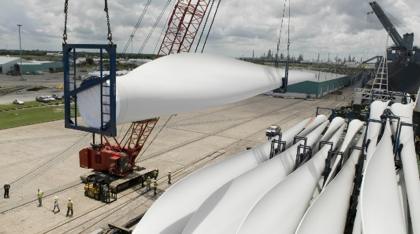Solar energy sucks up a lot of research attention, partly because solar energy systems still have so much room for improvement. Wind turbines, on the other hand, have been around for over 1,000 years, and although the modern versions are vastly larger and more efficient than their ancient counterparts, the basic concept hasn’t changed much.
But the standard blades-on-a-horizontal-axle version of wind energy systems (as opposed to more exotic flavors like kites or blimps) may yet be poised for some big leaps forward, several of which were profiled in a recent Clean Break column.
I’ve already covered Catch the Wind’s laser-based system for creating 3-D maps of wind direction and speed. That technology would seem to pair well with a new gearbox design from ExRo that allows turbines to much more efficiently turn fluctuating air currents into stable electricity.

Presently wind turbines use a mechanical transmission to smooth out the speed at which energy is delivered to an internal generator. Think of the way in which the gears of a bicycle allow you to pedal at a roughly constant speed whether you’re going uphill or down.
Mechanical transmissions work well enough, but they’re both expensive and somewhat inefficient. ExRo’s design does away with the old gearboxes and replaces them with a generator that can electronically adapt to different wind speeds. The resulting system can harness wind at both higher and lower speeds than traditional designs and may boost energy output by up to 50 percent while lowering costs.
Then there’s WhalePower Corp, a small Canadian start-up that has discovered that whales themselves are a renewable source of biomass — called “blubber” — that can be used to sustainably light and heat our homes. No, wait, they’ve discovered that whale fins provide lessons in fluid dynamics that can dramatically improve the design of wind blades.
The story begins when Dr. Frank E. Fish (seriously) took notice of the odd series of bumps on a the front of a humpback’s fins, a seeming contravention of the notion that the leading edge of a wing should be smooth and streamlined. Several research studies and design patents later, WhalePower believes that it has solved some longstanding problems in wind turbine design, allowing them to harness energy in the air more efficiently.
Elsewhere, mechanical engineering professor Majid Rashidi hopes that using curved surfaces to act as a sort of lens for concentrating the wind’s energy will help to make small-scale wind turbines more economically viable. In a similar vein, FloDesign is working to improve an old idea: surrounding a wind turbine with a shroud that funnels air toward the blades.
Long story short: the next time you read an article on cost barriers to wind, remember that a lot of those barriers are poised to fall.
